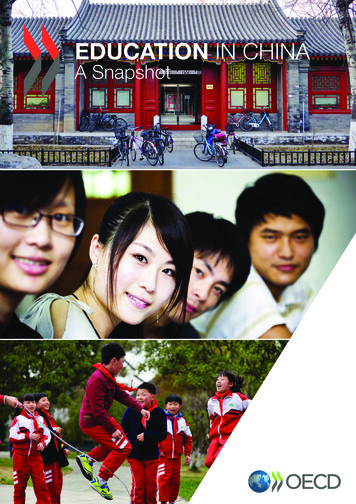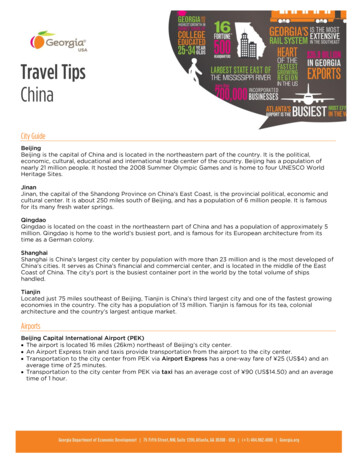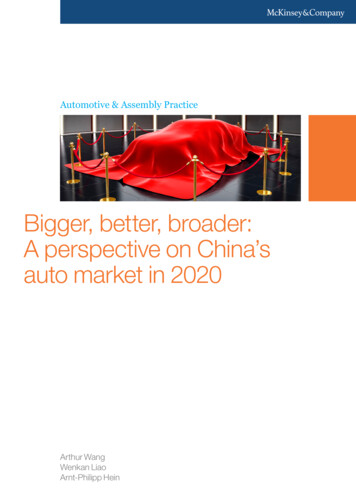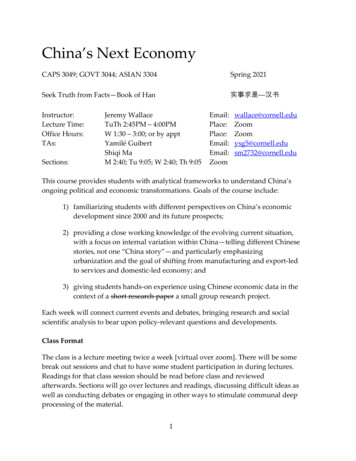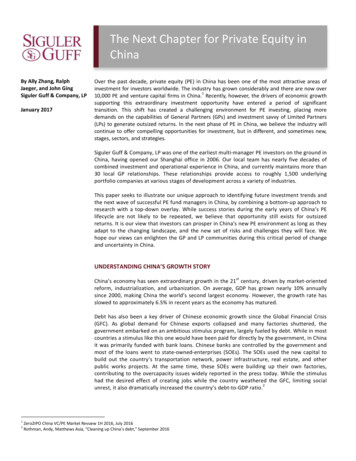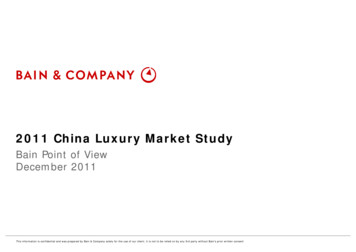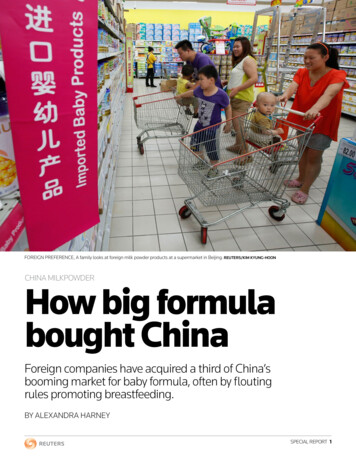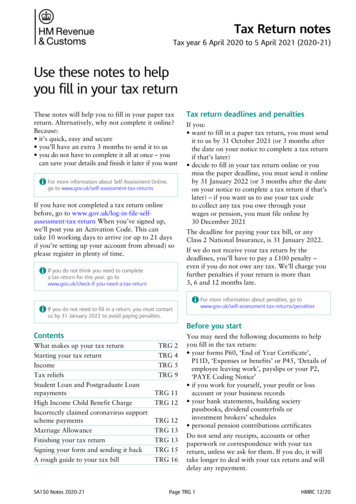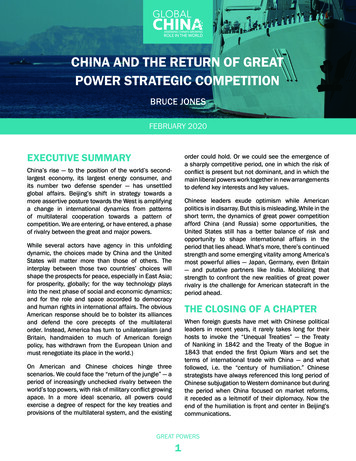
Transcription
CHINA AND THE RETURN OF GREATPOWER STRATEGIC COMPETITIONBRUCE JONESFEBRUARY 2020EXECUTIVE SUMMARYorder could hold. Or we could see the emergence ofa sharply competitive period, one in which the risk ofconflict is present but not dominant, and in which themain liberal powers work together in new arrangementsto defend key interests and key values.China’s rise — to the position of the world’s secondlargest economy, its largest energy consumer, andits number two defense spender — has unsettledglobal affairs. Beijing’s shift in strategy towards amore assertive posture towards the West is amplifyinga change in international dynamics from patternsof multilateral cooperation towards a pattern ofcompetition. We are entering, or have entered, a phaseof rivalry between the great and major powers.Chinese leaders exude optimism while Americanpolitics is in disarray. But this is misleading. While in theshort term, the dynamics of great power competitionafford China (and Russia) some opportunities, theUnited States still has a better balance of risk andopportunity to shape international affairs in theperiod that lies ahead. What’s more, there’s continuedstrength and some emerging vitality among America’smost powerful allies — Japan, Germany, even Britain— and putative partners like India. Mobilizing thatstrength to confront the new realities of great powerrivalry is the challenge for American statecraft in theperiod ahead.While several actors have agency in this unfoldingdynamic, the choices made by China and the UnitedStates will matter more than those of others. Theinterplay between those two countries’ choices willshape the prospects for peace, especially in East Asia;for prosperity, globally; for the way technology playsinto the next phase of social and economic dynamics;and for the role and space accorded to democracyand human rights in international affairs. The obviousAmerican response should be to bolster its alliancesand defend the core precepts of the multilateralorder. Instead, America has turn to unilateralism (andBritain, handmaiden to much of American foreignpolicy, has withdrawn from the European Union andmust renegotiate its place in the world.)THE CLOSING OF A CHAPTERWhen foreign guests have met with Chinese politicalleaders in recent years, it rarely takes long for theirhosts to invoke the “Unequal Treaties” — the Treatyof Nanking in 1842 and the Treaty of the Bogue in1843 that ended the first Opium Wars and set theterms of international trade with China — and whatfollowed, i.e. the “century of humiliation.” Chinesestrategists have always referenced this long period ofChinese subjugation to Western dominance but duringthe period when China focused on market reforms,it receded as a leitmotif of their diplomacy. Now theend of the humiliation is front and center in Beijing’scommunications.On American and Chinese choices hinge threescenarios. We could face the “return of the jungle” — aperiod of increasingly unchecked rivalry between theworld’s top powers, with risk of military conflict growingapace. In a more ideal scenario, all powers couldexercise a degree of respect for the key treaties andprovisions of the multilateral system, and the existingGREAT POWERS1
GLOBAL CHINACHINA AND THE RETURN OF GREAT POWER STRATEGIC COMPETITIONThis is propaganda, of course, and for the Chineseleadership it has two purposes. Internally, it is part ofa deliberate effort to replace the legitimating narrativeof continuing Chinese Communist Party rule, switchingfrom an emphasis on fast economic growth to a narrativeof ambitious nationalism. This is a necessary shift asChinese growth slows from the stratospheric highs ofthe 1990s and 2000s to its current modest levels. Butinternationally, Chinese leaders are also expressingtheir ambition to play the game of international orderfrom pole position. The international order has been inconstant evolution, including in the post-Cold War era;now China wants to drive a new set of changes.notion that America, Russia, Britain, and China wouldeach work to provide security in their own sphere ofinfluence.1 That concept ended up embedded in thestructure of the veto-wielding members of the U.N.Security Council (British Prime Minister WinstonChurchill insisted that the French get a veto as well)but did not survive its first test with reality, to wit theU.N. effort at reconstruction of Eastern Europe, norRoosevelt’s death.2 The differences in U.S. and Sovietperspectives on postwar Europe and Harry Truman’sdeep distrust of Joseph Stalin quickly put paid to the“four policemen” moment.What followed was the Marshall Plan and the start ofthe Cold War. And that did set some essential patterns:a mutual self-defense pact with Western Europeagainst the Soviet Union; the forward deployment ofAmerican troops and airpower in Europe and Asia; andthe restoration of substantial economic ties betweenthe United States and Europe (and later, with the Asianpartners.) The patterns and concepts of what we nowrefer to as American leadership of the free world wereborn in this period. The titanic struggle against theSoviet Union provided an existential rationale for thisorder and America’s vital role within it. America alsotook on the role of guaranteeing the free flow of oil outof the Persian Gulf, giving it a sustained rationale forpolitical and military engagement in the Middle East.3Admittedly, there was much that was hardly liberal inthis phase, especially in America’s foreign policy inthe “Third World”; in some regions, that legacy stilltarnishes the West’s efforts to defend a “liberal order.”While China under Xi Jinping expresses a sense ofconfidence, even hubris, about its capacity to reshapethe rules of the game, and the United States underDonald Trump is engaged in a kind of denialist narrativeabout its ability to impose order without allies andsuppress Chinese ambitions without costs, the realityis that both the United States and China confront a setof uncomfortable and consequential choices. The nowvery real power gap between these two top powers andeveryone else is a central reality of international order.The other powers must worry about Washington’spreferences, Beijing’s preferences, and the tensionsbetween them. But the power gap between the UnitedStates and China is still very real, too — especially ifAmerican leaders reverse the erosion of political tiesto the allies.BACKDROP: AN EVOLVINGINTERNATIONAL ORDERMuch of the rhetoric and some of the patterns of theCold War period continued into the post-Cold Warera; but in reality, the basic structure of internationalrelations changed. Dramatically so: the collapse of theSoviet Union opened a moment of international affairsin which there was only one, dominant great power, theUnited States, which stood alone astride internationalaffairs with no peer competitors and few intrinsicconstraints.4It is commonplace to hear American pundits andpolicymakers talk about a 75-year tradition ofAmerican foreign policy premised on defense of a“liberal international order.” In point of fact, both thenature of international order and America’s role in ithas evolved considerably during the period since thesurrender of Germany and Japan ended World War II.Both have evolved through several decades, markedby key changes in the structure of power.The first decade of this third phase of the order saw theU.S. behave in a very unusual way: it chose to exerciseits hegemonic power in large part by advancingmultilateral institutions for trade and security, andinviting formal rivals to join those institutions.5 It wasa period of shared prosperity and relative comity inThe first phase was brief and more aspirational thanactual. In the design of the Bretton Woods institutionsand in U.S. President Franklin Delano Roosevelt’simage of postwar life, the central pillar of order wasto be the concept of the “four policemen” — theGREAT POWERS2
GLOBAL CHINACHINA AND THE RETURN OF GREAT POWER STRATEGIC COMPETITIONgreat power relations — not totally free of tensions butlargely free of a risk of military clashes among the toppowers.6 In parts of the developing world, the first partof the post-Cold War era saw a surge in civil wars; butas the era continued, dedicated conflict managementefforts saw wars decline steadily, in all regions.7 Widerconcepts of liberalism — connected to the spread ofdemocracy and the advance of human rights — beganto appear more centrally in the rhetoric of the West,and sometimes in its actions.8of globalization.10 Yet during this period the Westernpowers extended their engagement in internationalorder and expanded the scope of the normative reachof it — incorporating concepts like “the Responsibilityto Protect” and humanitarian intervention into someelements of strategy. The gap between the reach of theWestern powers and the ambition of the order grew.“What followed was a confusedand turbulent decade, leavened bywidespread international support forPresident Barack Obama but in factlaying the groundwork for presenttensions.This post-Soviet strategy was sharply interrupted by theal-Qaida attacks of September 11, 2001 and the startof what would become nearly two decades of sustainedAmerican warfare in the wider Middle East. Briefly,it seemed as if this strategy would actually deepenAmerican leadership and bring even more countriesinto its sphere or into active security cooperation withthe United States, as wide coalitions joined forces withthe U.S. in Afghanistan to tackle al-Qaida. The IraqWar, though, strained this wider coalition and beganto erode fulsome support for American leadership.Still, the scale of American power and the absenceof alternative economic or security powers left theUnited States broadly in command of the dynamics ofinternational order.What followed was a confused and turbulent decade,leavened by widespread international support forPresident Barack Obama but in fact laying thegroundwork for present tensions. Key markers of theuncertainty of the times came in Russia’s seizureand annexation of Crimea from Ukraine; in U.S.-U.K.dithering over Syria, and Russia’s decision to deployforces there (returning significant Russian militarypower to the Middle East for the first time since the fallof the Berlin Wall); in China’s decision to install militaryfacilities initially on Woody Island in the South ChinaSea and more broadly to expand its coercive posturein the South and East China Seas; and in the failureof the so-called “developing world round” of the WorldTrade Organization (WTO) talks. These dynamics ofdeterioration were alleviated by episodes of successfulcooperation — for example in the negotiation of aglobal climate agreement in Paris in 2015, in therobust international response to the 2014-2016 Ebolaoutbreak in West Africa, and in the 2015 conclusionof the P5 1 nuclear deal with Iran — but they were notreversed by these more positive developments.The Arab Spring, the global financial crisis, and thegrowth of the “rising powers” conspired to bring thisphase of American unipolarity to a close and moveus into a fourth phase of the order. The overthrow ofdictators in Tunisia and Egypt and the subsequentdescent of the wider Middle East and North Africainto a sustained dynamic of internal and regionalstrife drew the United States further into the turbulentregion and created wider fissures between Washingtonand its allies and partners, both European and MiddleEastern. And this came after the global financial crisisbled the American treasury and strained internationalconfidence in the competence of Washington tomanage international economic affairs (althoughWashington did also lead the G-20 response to thecrisis).9 These events came at a point in internationalaffairs when the “rising powers” — most importantlyChina, but also India, a recovered Russia, Brazil, Turkey,and others — had reached a point in their own growththat they had the economic muscle and diplomaticclout needed to start to push back on Westerndominance of international institutions and the rulesAnd all that was before the Brexit referendum and theelection of Donald Trump brought skeptics of integrationto power in London and Washington — the two keyarchitects of the international system. It remains tobe seen whether Brexit and Trump’s victory mark theend of U.S. and U.K. commitment to multilateral order,or merely significant bumps in the road. But even ifGREAT POWERS3
GLOBAL CHINACHINA AND THE RETURN OF GREAT POWER STRATEGIC COMPETITIONnew elections or changing political views pull Londonand Washington back to an internationalist worldview,the West now confronts new realities in the shaping ofinternational order.the second-largest economy in the world (in nominalGDP terms), the second-largest defense budget, andthe second-most-important technology sector. It isnumber one in population, and the largest energyimporter and largest carbon emitter in the world. Moredebatable is the new strategy, but few would querythe notion that China under Xi Jinping has shed itsold strategy of “peaceful rise” (together with the moresubtle “hide and bide”) in favor of a more assertive,more nationalist, and more ideological approach.11Whether that strategy is also confrontational is aquestion we’ll return to.WHAT WORLD DO THEUNITED STATES AND CHINACONFRONT?This brings us to a world in which the choices thatWashington and Beijing make will be the mostconsequential factors shaping international order andgreat power competition. They will not make thosechoices in an empty space, though. Rather they bothconfront an international arena with a number ofcomplicated features. It’s become commonplace torefer to this moment (2016 onwards) as marked bya return to great power competition. But what are thecontours and elements of that? Six features of thelandscape shape the choices available to Washingtonand Beijing.The third feature of the present order is not a thirdplayer — it’s the sizeable gap between the power of thetop two players and all the rest. Several other playershave a world-leading capacity in one issue space; butonly the United States and China now have genuinelyglobal economic and political influence, with the UnitedStates also having global military capacity — and Chinapotentially catching up on that score. What’s more,the first mover advantages of technological prowess,especially in artificial intelligence (AI), is increasing thepower gap between the top two players and the rest.The first is the continued scale and weight of theUnited States. For all the talk of decline and all theretreat to semi-isolationist instincts, the United Statesremains the world’s largest individual market, has thelargest and most powerful armed capacity in the world,and has a network of global bases and relationshipsthat is eroded but far from eclipsed. It’s the largestenergy exporter in the world (though still a very largeimporter), hosts the most powerful technology firms,and its research universities remain in a league of theirown. Notwithstanding the utter failure of the politicalclass in Washington to protect let alone buttressthese assets, they will endure for period to come —how quickly they erode will primarily be a functionof U.S. domestic policy. China’s propaganda andinternational posture (like Russia’s) aim to highlightWestern weakness for the purpose of eroding Westernself-confidence; but the reality of continued Americanand European material strength and strengths in theWestern model limits the effectiveness of Chinesediplomacy — especially as China increasingly shows itscards in its international dealings.The alliance dynamic thus becomes — or moreaccurately, has returned to being — a central dynamic inthe balance of power. The U.S.-led system of alliancesencompasses 15 of the top 20 militaries in the world.That system has been frayed by a lack of focus inthe second term of the Obama administration andby outright contempt from President Trump (thoughnot from his administration), but it is not yet brokenand still constitutes a weighty fact in internationalaffairs. The challenge of the alliance system is this:the most coherent part, NATO, lacks a clear strategicfocus, while the most geographically relevant part,the network of bilateral alliances in Asia, lacks aneffective operational structure. The alliance structureis a powerful latent geopolitical fact; mobilizing it toconfront the dynamics of a changing order is the keychallenge for American statecraft.The fourth feature of the contemporary order is a layerof major powers vying for space and security. These arethe European Union (and within that body Germany,and to a lesser degree France, enjoying both cloutwithin the European institutions and outside them),Britain (now formally out of the EU and engaged inThe second is the new position and evolving strategyof China. The position is unquestionable: China is nowa clear number two in the international system, withGREAT POWERS4
GLOBAL CHINACHINA AND THE RETURN OF GREAT POWER STRATEGIC COMPETITIONrenegotiating trading relationships), Russia, India, andJapan. Each of these countries or entities has a majorpopulation, substantial economic weight, or militaryheft — but none have all of them. The rest of the G-20,countries like Saudi Arabia, Turkey, South Korea,Brazil, Indonesia, and the smaller Western economies,all have some degree of economic or diplomatic cloutwithin the system, but not at the same level as themajor powers — all of which wield a population of 65million or more and a top 10 economy. Collectively,though, they are a consequential fact of internationalaffairs — and it was only with Brexit last month that theChinese economy surpassed that of the EU in nominalterms.course it may soon find allies and partners like SouthKorea, Turkey, and the United Arab Emirates forgingvery different kinds of relationships with Beijing andMoscow. China’s relations with India remain a complexmix of competition, outright rivalry, occasional limitedhostility, and important collaboration.13A fifth feature is the continued existence of a wide anddeep network of multilateral institutions, commitmentsand mechanisms that bind together large parts of therest of the world, and in which deep habits of cooperationhave been forged — especially in the issue spaces ofdevelopment, infrastructure, climate, and health. Chinais taking active advantage of America’s myopic underattention to multilateralism to penetrate and attemptto reshape that system to its advantage, or at least tolimit the West’s continued ability to use that system asa force multiplier for its own interests and values. Themajor multilateral mechanisms are frayed and fragile,but not yet abandoned or broken.14 And they enjoysomething that the strategic elites of the great powersdo not: widespread corporate, civic, and youth support.While these players are similar in the weight they carryin international affairs, their strategies are radicallydifferent. Russia, as an economic welterweightand an energy heavyweight, has thrown a hugelydisproportionate amount of its GDP into retaining/regaining a globally competitive nuclear/conventionalmilitary capacity. It has adopted a strategy of probing,risk-taking, and provoking designed to weaken theunity of NATO — with some success. Europe, for itspart, is meeting the rise of China, the aggression ofRussia, and the unilateralism of the United Stateswith a combination of bewilderment, nostalgia, andhesitant exploration of self-help approaches that so farfall well short of a credible strategic response. India —which perhaps has the greatest intrinsic capacity to reweight the options facing China and the United States— seems content to play a role of suitor to many, brideto none, eschewing an ordering role despite rhetoricto the contrary. Japan, militarily weakest and mostvulnerable of these second-tier players, is unique inhaving adopted a credible strategy of buttressingeconomic multilateralism and pressuring both Beijingand Washington to moderate their escalatory dynamic— with some success.12“China is taking active advantage ofAmerica’s myopic under-attentionto multilateralism to penetrate andattempt to reshape that system toits advantage.And that constitutes a sixth feature of the contemporarysystem — the presence of an informed and active,increasingly activist, network of civic organizations,private sector companies, and publics. Thosedynamics — different from but overlapping with thepopulist politics that have generated both left and rightdisruptions in Europe and Latin America, to say nothingof the United States and Britain — constitute a featureof international politics easily overlooked in strategicassessments. They are not likely to be a powerfulenough force to prevent the United States and Chinafrom locking into strategic hostility, and in some issuespaces like human rights may amplify that escalatorydynamic. But in other domains, like climate change,they may constitute a check on a rush to rivalry.The Leninist nature of the Chinese system and itsforeign policy means that it has no such alliance optionavailable to it — but there is a growing degree of policycoordination with Russia, approaching the featuresof a “concert” arrangement. Moscow and Beijingshare an overarching interest in further weakeningthe West’s hold on the key dynamics of internationalorder. And if American policy continues in its presentGREAT POWERS5
GLOBAL CHINACHINA AND THE RETURN OF GREAT POWER STRATEGIC COMPETITIONLess certain is the role that will be played by the technologygiants of the West Coast of the United States and China’sdynamic cities. For all the technology nationalism of “Madein China 2025” and “America First,” the fact remains thattech giants on both sides of the Pacific remain deeplyintertwined. It is a remarkable feature of the moment thatone of America’s most influential artificial intelligencecompanies, Microsoft, could announce within monthsthe following two decisions: winning the Pentagon’s 10billion tender for cloud computing services, and a largescale expansion of its AI research hub in Shanghai.for deeper cooperation in fiscal and military affairs:instead we see Brexit and the resurgence of far-rightparties across the European landscape. Each of thesedynamics is adding to disorder and the risk of conflict.However, even if the United States renews its focuson the alliance structure and multilateralism, it willconfront some uncomfortable realities. First amongthem is the simple fact that the economic andtechnological weight of China — now, not in the future— means that China will be able to claim a full seat atthe table in the writing of the next phase of the rulesof the international trade, financial, and technologicalorder. Will the United States accede? It would markthe first time in nearly two centuries that an illiberalpower has had a major voice in the shaping of therules of international commerce. (The Soviet Unionnever sought to play this role in more than an episodic,blocking way.) That would mean ceding some degreeof control to a country whose political system is movingin the opposite direction of the West’s — away frommarket reform and incremental advances of the rule oflaw, towards fuller social control and an increased roleof the state in the economic sphere. Combined withaggressive human rights suppression in Xinjiang anddeepening political control through social monitoring,the Chinese approach may simply be too unpalatablefor the West to accede to a sharing of power. If so, weare likely to see some areas of economic decouplingaccelerate (at substantial cost to both), and perhapsthe emergence of two zones of globalization. Globaleconomics would go from being a source of perceivedstability in U.S.-China relations to a zone of contestationand systemic competition. (The echoes of the 1880swould reverberate particularly loudly in this scenario.)Taken together, these features of the contemporaryinternational system will shape and constrain thedynamics of great power competition. And all of itconfronts strategists in Washington and Beijing withcomplex, and mostly uncomfortable, choices.WHAT CHOICES DO THE GREATPOWERS HAVE?It’s indicative of the continuing power of the UnitedStates that the most important question regarding thenext phase of great power relations and internationalorder is a question about American policy: willWashington recommit to the alliance system, andperhaps to a wider sense of multilateral order, or will itallow those commitments to continue to fray?If the United States more deeply abandons its alliancecommitments or more fully alienates its core allies,the first effect of this will be to make the world saferfor Russian adventurism and Chinese ambition. Somehave argued differently, making the case that it is thevery fact of the alliance structure that is provokingChinese and Russian behavior and that a retreat fromits forward posture in Asia and Europe will lead tomore stable self-help arrangements among our formerallies.15 While the point needs to be argued country bycountry, the early evidence is not encouraging. Turkeycould have taken diminished U.S. interest in the MiddleEast as an opportunity to deepen ties with Berlin andBrussels; instead it has turned towards Moscow. Japanand South Korea could have taken their growing concernabout the credibility of America’s commitment in Asiaas an opportunity to bury the hatchet and join hands inblunting the effect of Chinese pressure; instead theirrelationship is in its worst state in decades. Europecould be treating an inward turn in America as groundsChina confronts uncomfortable realities as well. AlthoughXi Jinping conveys a sense of exuberance about China’snew status, the fact is that he confronts a degree ofelite discontent at home, and a deteriorating reputationin the West (and in some parts of the developing world;though in others, China has adapted its tactics andimproved its standing.) For all of the displeasure ofEuropean elites and publics about American politicalunilateralism, few are so gullible as to confuse theirunhappiness about contemporary American policywith sympathy for China’s own brand of increasinglyassertive unilateralism, let alone Russia’s recklessness(which China not only tolerates but indirectly enables). AGREAT POWERS6
GLOBAL CHINACHINA AND THE RETURN OF GREAT POWER STRATEGIC COMPETITIONsmall number of countries where public opinion carrieslittle sway may feel forced or tempted to move towardsthe Chinese camp, but Chinese behavior, at home andabroad, is starting to increase the costs to its diplomacy.If China wants to pursue a more robust strategy, witha greater focus on coercive instruments, it also has asteep hill to climb. Let us presume for a moment — andthe preponderance of evidence suggest that this is so— that China wants to have what the United States hasenjoyed: the ability to project hard power, in additionto the political and economic influence it can alreadywield, at a global level. That is a necessary feature oftrue great power status, and a necessary feature ofeffective competition with the United States — at leastin classical terms. To develop the most importantfeature of global power projection, a global blue waternavy, China has to overcome the following obstacles: ahighly sophisticated American global navy that showsno signs of giving ground; Japan’s not inconsiderablenaval capacity right off its eastern shore; a furtherchain of islands from its northeast to its southeastthat can hem in its naval power projection; Europe’sresidual global naval capacity which, while modest,usefully amplifies U.S. capacity; and India’s extremelyinconvenient geography and growing appetite for powerprojection in the Indian Ocean.16 That is to say nothingof significant technological-bureaucratic obstaclesto the kind of sea-space-land linkages required tooperationalize a global navy in times of pressure.What’s more, China confronts an unenviableinternational structure, most notably in the form of theimmediate presence on its eastern borders of a networkof U.S. allies. It may, overtime, succeed in weakeningthe alignment of some of those allies, like the thePhilippines or South Korea. But not others — there arefew historically credible scenarios that sees Japan orAustralia fall into the Chinese camp. It also confrontsa United States that even in a moment of deep internaldivision has forged a growing elite and social consensusabout the problem of China — though, not yet a fleshedout strategy for wide-spectrum containment. And itconfronts an international system that has grownaccustomed to the more liberal tendencies of the UnitedStates — including its stated policy, more honored thanignored in the post-Cold War period, of allowing evensmall countries to choose their own alliances andgovernance. None of this makes it easy for China totranslate its new weight into actual clout.An obvious strategy for China is not to confront theUnited States, but to erode its influence. This could beaccomplished by persistent application of the followingpolicy measures: Supplanting the United States inthe developing world by providing a combination ofloans on attractive terms, technological and financialknow-how, non-interference on policy and support inmultilateral institutions; fill gaps left by U.S. myopia inshaping the work of multilateral institutions; deepenfinancial and strategic ties with other countries that feelthreatened by the United States or the West, includingRussia and Iran; and impose substantial financial andpolitical costs on countries in its own neighborhood orwith whom it has advanced ties if they align with theUnited States. Washington manages to score repeatedown goals here, so poorly crafted are U.S. developmentpolicy and multilateral engagement (beyond NATO).But Beijing confronts a more formidable challengefrom a combination of Brussels, London, Berlin, andabove all Tokyo, all of which have substantial assets tooffer developi
On American and Chinese choices hinge three . refer to as American leadership of the free world were born in this period. The titanic struggle against the .



